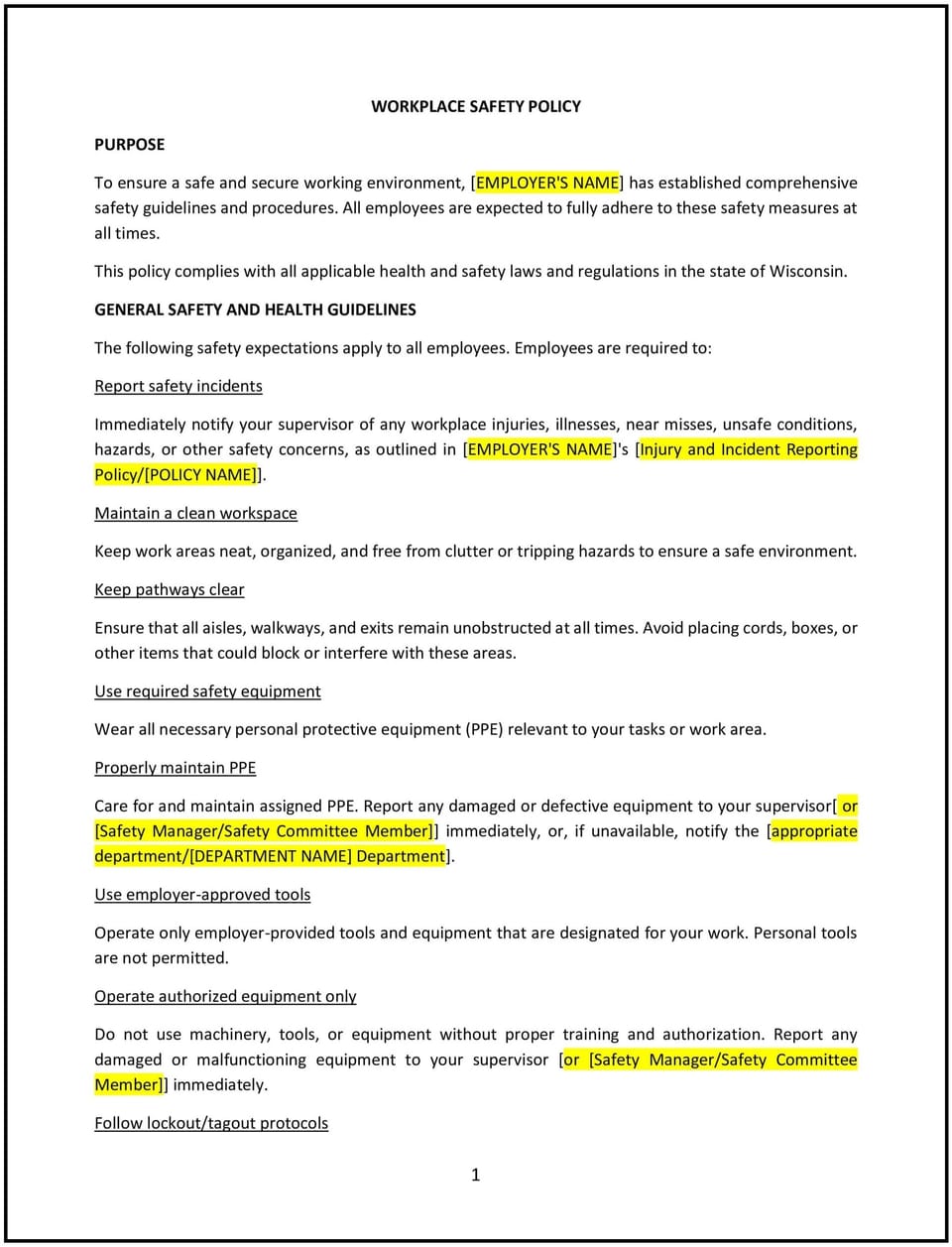Workplace safety policy (Wisconsin): Free template

Workplace safety policy (Wisconsin)
In Wisconsin, a workplace safety policy establishes guidelines for maintaining a safe and healthy work environment for all employees. This policy outlines the organization’s commitment to identifying, preventing, and addressing potential hazards, promoting compliance with Wisconsin safety laws and OSHA regulations.
The policy defines safety responsibilities, preventive measures, and procedures for reporting and resolving safety concerns to foster a culture of safety and accountability.
How to use this workplace safety policy (Wisconsin)
- Define safety responsibilities: Specify the roles and responsibilities of employees, supervisors, and management in maintaining workplace safety.
- Establish reporting procedures: Provide clear steps for employees to report hazards, injuries, or unsafe conditions, including designated contacts and required documentation.
- Implement preventive measures: Include strategies such as regular inspections, safety training programs, and hazard mitigation plans.
- Set emergency protocols: Outline procedures for responding to emergencies, such as evacuations, first aid, and contacting emergency services.
- Support compliance: Align the policy with Wisconsin labor laws and OSHA regulations to meet legal and safety standards.
Benefits of using a workplace safety policy (Wisconsin)
- Enhances safety: Reduces the risk of workplace accidents, injuries, and illnesses, creating a secure environment.
- Supports compliance: Promotes adherence to Wisconsin safety laws and OSHA regulations, minimizing legal risks and penalties.
- Improves morale: Demonstrates a commitment to employee well-being, fostering trust and engagement.
- Encourages accountability: Sets clear expectations for maintaining workplace safety and reporting hazards.
- Adapts to local needs: Reflects Wisconsin’s unique industries, such as manufacturing, agriculture, and healthcare, which have specific safety considerations.
Tips for using a workplace safety policy (Wisconsin)
- Communicate effectively: Share the policy with employees during onboarding and ensure it is accessible for reference.
- Provide regular training: Offer safety training programs tailored to the organization’s specific risks and workplace hazards.
- Conduct inspections: Perform regular safety inspections and address potential hazards promptly.
- Document incidents: Maintain detailed records of workplace incidents and corrective actions to ensure transparency and compliance.
- Review periodically: Update the policy to reflect changes in laws, workplace practices, or industry standards.
Q: What does the policy define as workplace safety?
A: Workplace safety includes practices, behaviors, and procedures that prevent accidents, injuries, and illnesses while fostering a secure work environment.
Q: How can employees report safety concerns?
A: Employees can report hazards or unsafe conditions to their supervisor, HR, or a designated safety officer. The policy should outline specific reporting procedures.
Q: What preventive measures are included in this policy?
A: Preventive measures may include regular safety training, hazard assessments, and the use of personal protective equipment (PPE).
Q: How does this policy align with Wisconsin laws?
A: The policy helps achieve compliance with Wisconsin labor laws and OSHA standards, improving legal adherence and promoting a culture of safety.
Q: How does this policy benefit Wisconsin businesses?
A: A workplace safety policy enhances safety, supports compliance, and reduces risks, contributing to employee satisfaction and operational efficiency.
This article contains general legal information and does not contain legal advice. Cobrief is not a law firm or a substitute for an attorney or law firm. The law is complex and changes often. For legal advice, please ask a lawyer.


